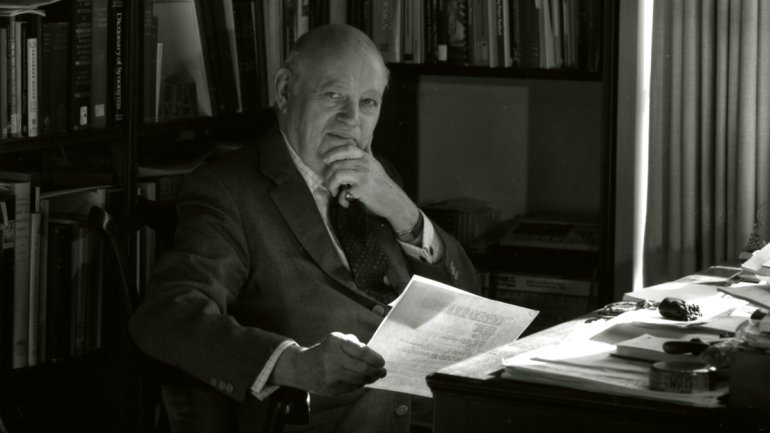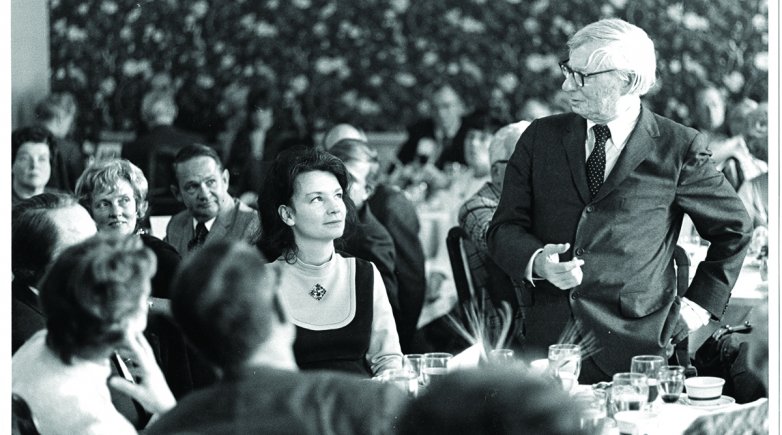Lou who? How Kahn came to Exeter
The story of how Louis Kahn came to design the Academy library is a tale with many heroes.
Rodney Armstrong ’68 (Hon.) served as the Academy’s librarian for 25 years, shepherding the school through the long and careful process of building a new library. This article, originally published in The Exeter Bulletin in 2004, is adapted from a talk he gave at a symposium at Yale University on Kahn’s life and work. Armstrong passed away in April 2021 at 98.
When I arrived at Exeter in 1950, it was with the promise that I was to lead the effort of designing a new library for the Academy.
The Exeter I encountered was definitely not a St. Grottlesex school. It was vaguely Congregational, but its god was academic achievement. The faculty was formidable, with an exceptionally strong history department determined to get a library appropriate to support their efforts. It would replace the charming but small Davis Library, which had been designed by Ralph Adams Cram and built in 1912 for a school of just 500 students. The history department’s representative on the library committee was Albert Ganley, who heroically stuck with us to dedication day.
Eventually, after a number of years and strenuous collaborative efforts, our Trustees appointed an architect, one who was responsible for the libraries at Barnard, Amherst and West Point. The Trustees’ instructions were as follows: to anticipate the Academy’s needs for the next 25 years and to design and exterior that would “blend in with our beautiful Georgian buildings.” The architect was nice, capable, attentive.
As we became involved with final drawings, Exeter got a new principal: Richard Ward Day, an ex-Marine captain as well as an educator. By chance, Dick Day and I met one day on a school path in front of a newly constructed dormitory, which looked like a Howard Johnson motel that had lost its way. Our new principal was dismayed by what he saw and asked me for an explanation, the gist of which was that it was a faculty committee effort with the aid of the second-largest architectural firm north of Portland. When Dick Day learned that this same firm was involved with a renovation of the gymnasium, he fired the architect and eventually Exeter got a sports palace designed by Kallman & McKinnell, the same firm that designed Boston’s Government Center. (I was always grateful for the sports palace, as no matter how palatial our plan for the new library became, it appeared modest by contrast.)

When Principal Day learned that I was way down the road with plans for the new library, he spent an afternoon reviewing the plans. When he finished, he asked my opinion. I responded that the plans met the program requirements and the Trustees’ request that the building blend in with the adjacent structures. Dick Day looked me in the eye and asked me if I liked it. I had to respond that it was not to my taste. He replied that he was firing the architect and appointing me chairman of the faculty committee, whose members were to be suggested by me, to rewrite the program to propose “the outstanding contemporary architect in the world” to design Exeter’s new library. We were to receive and consider suggestions from trustees, colleagues, alumni and friends, and to travel anywhere, here and abroad, as we thought best, to look at buildings. Principal Day was no piker, but a hero. I had also blown about eight years of planning.
At the first meeting of our small committee, Elliot Fish of the modern languages department startled us by saying he didn’t know why we were going through such a lengthy procedure when he could tell us right then and there who our choice would be. Silence was followed by dubious murmurs and calls of “Who?”
“Why, Lou Kahn, of course,” he replied.
“Lou who?” we chorused.
Among the many concerned letters, visits and telephone calls our committee received were too calls to me from Dr. Jonas Salk, the developer of the polio vaccine and the father of Peter Salk ’61, who had been a student in the dormitory where I lived. Jonas Salk insisted I visit the Salk Institute for Biological Studies in La Jolla, California, which had been designed by Louis Kahn. When I arrived, Jonas spent hours showing me around. His love for the building was palpable. “No other architect could have done this, Rodney,” he told me. I didn’t have to convinced; I thought the Salk Institute was glorious.
There followed many other trips. Our committee compiled a list of architects to be interviewed at their offices after they had considered our written program and other materials about Exeter. All wanted the commission.
With months flying by, the time came when our list of final choices had to be submitted to the Trustees. It was a time of great anxiety: Our committee was unanimous in their recommendation of Kahn above all others, yet Kahn had so few buildings constructed compared to the other architects on our list. But we were sure, so sure.
Enter another hero. Our Trustees, having placed such trust in a faculty committee, had also appointed an adviser on building and grounds: Nelson W. Aldrich of Boston, an architect of considerable practice, and a friend of many of the trustees and of myself. Nelly came down firmly for our recommendation. We were home free. Louis Kahn received his commission from the Trustees in November 1965 and made his first visit to Exeter in January 1966. Groundbreaking began in April 1969, and the building was completed two years later.
In conclusion, I wish to express my gratitude to Lou Kahn: for the education he so generously gave me over the course of the library’s design and construction, and for what he did for Exeter, is students and faculty. His library fulfilled our dreams and hope and did indeed shift the center of our school world. Immodestly, I add that it is the greatest secondary school library, here or abroad.
Another hero is Jacquelyn Thomas ’45, ’62, ’69 (Hon.); P’78, ’79, ’81, who succeeded me as Exeter’s librarian in 1975 and who has fiercely and successfully maintained the integrity of Kahn’s library through the necessary replacements and refreshments of the ensuing years. My only regret? That the Academy’s coffers did not permit the landscaping outside which would have completed Kahn’s dream for Exeter.
